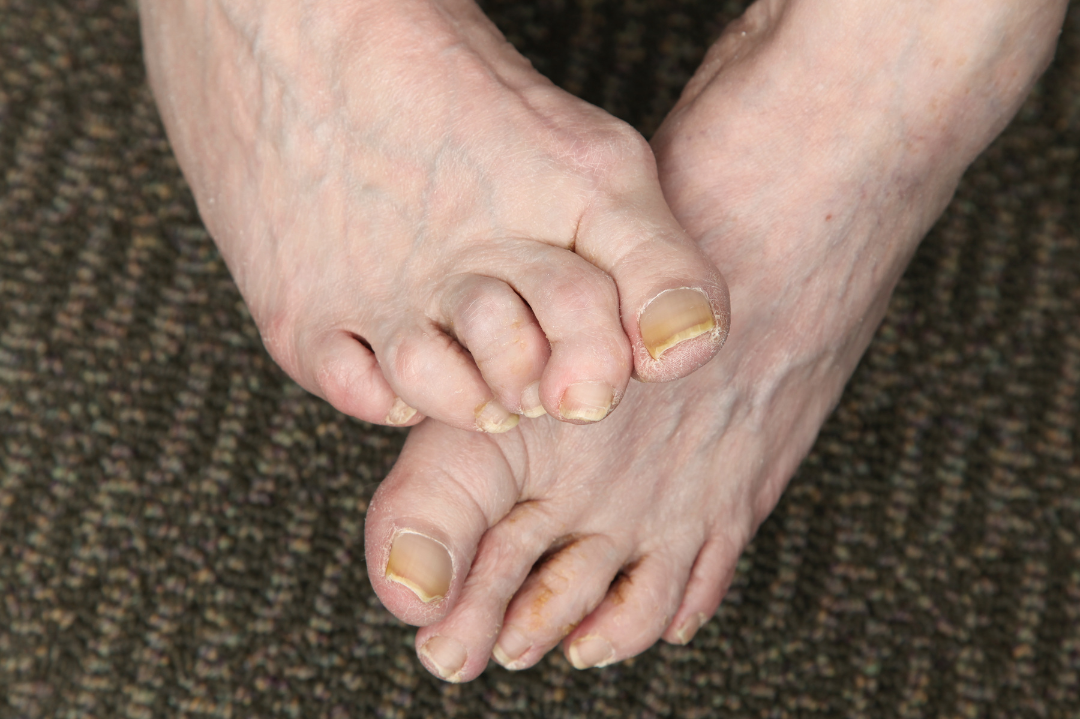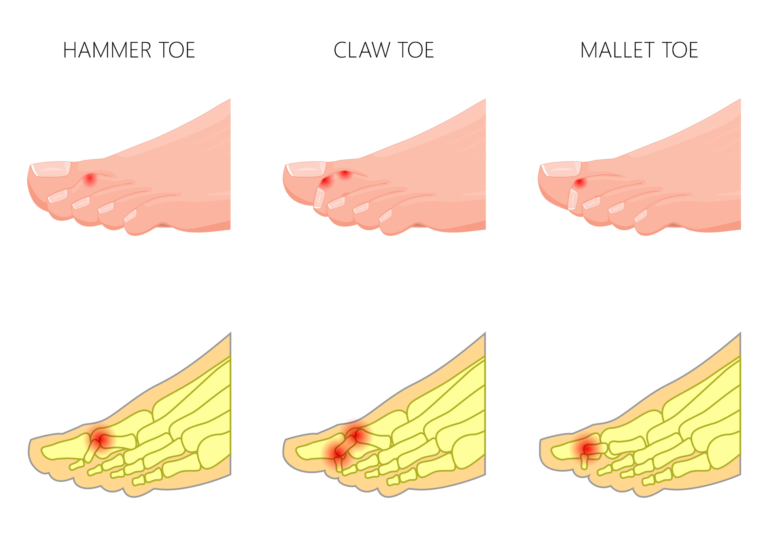
Jump to section
Noticing that you or your child have curly toes can be quite concerning, leaving you wondering about why your toes are curled, whether they’ll cause you any problems, and if they’re going to straighten - or if you should be seeing someone to have them treated. Our Brisbane podiatrists are experts in foot and leg health, working with a wide range of toe problems, including a range of types and causes of curled toes.
When patients come to us to discuss their curly toes, there are usually two categories they fall into:

The cause of your curly toes will depend on what type of curly toe you have. For those with clinodactyly (pictured here), it may be
associated with a growth plate on one side of a toe bone that leads to the bone growing longer on only one side, leading to the bending
shape of the toe. It may also be associated with tendon tightness along the bottom of the foot that pulls down on the toe, causing it to
curl. This may be genetic and passed down in families, be part of a condition like Down’s Syndrome, or be idiopathic (of unknown
cause).
We often see toe deformities as a result of:
For clinodactyly, it is often the third, fourth and fifth toes that are affected. Some people may experience some pain or discomfort resulting from the toe position, or pressure on the toes from tighter footwear, while others don’t experience any pain. As a result of rubbing or pressure on the toes, corns and callus may form, as well as blisters. Toenails may also become bruised, or may grow thicker, flatten or change shape.
The symptoms of toe deformities are similar, with the development of blisters, corns, calluses and general discomfort being the primary symptoms. In this case, most people will start with straight, normal toes that will change shape over time as they’re exposed to the causative factors.
Regardless of the cause, our podiatrists can easily diagnose the presence and type of curly toes from a physical examination in our clinic.
From here, we’ll be able to discuss your symptoms, treatment options and prognosis.
The greatest risk factors are ongoing pain and discomfort - such as suffering from repeated corns and blisters, as well as having difficulty finding appropriate and comfortable footwear. This can make it hard to spend long periods of time on your feet, and enjoy activities like hikes and long walks with friends and family.
There are various management options for curly toes, and the best one for you will depend on the severity of your toe curling, the symptoms your curled toes are producing, and the underlying causes of your curled toes. We’ll discuss the best options for you on a case-by-case basis after your assessment, but your options may involve:
While toe deformities like hammertoes do not self-correct, it is estimated that approximately 25% of children with curly toes caused by clinodactyly may resolve spontaneously by six years old.
As footwear is the largest preventable contributor to curly toes, the best thing you can do is always choose comfortable, supportive footwear with a good-sized toe box - while avoiding tight, narrow or high heels.
Is having curly toes genetic?
It can be - but not always. Some people may inherit a tendency to develop curly toes from their parents due to differences in their foot structure, shape, or muscle imbalances that affect the toes. However, other factors such as wearing tight or uncomfortable shoes, having a foot or toe injury, or certain medical conditions can also contribute to the development of curly toes.
Can a podiatrist help with curly toes?
Absolutely. Podiatrists are specialists in foot care, and help manage a wide range of problems related to the toes including curly toes.
How can I straighten my curly toes naturally?
This depends entirely on the cause of your curly toes and their severity, but you podiatrist can talk you through various natural options such as working on any tight muscles and tendons in the foot that may be causing the curling.
| Monday | 7:40am - 6:00pm |
| Tuesday | 7:40am - 6:00pm |
| Wednesday | 7:40am - 6:00pm |
| Thursday |
7:40am - 6:00pm |
| Friday | TEMP CLOSED |
| Saturday | CLOSED |
| Sunday | CLOSED |
Ground Floor, 344 Queen Street,
Brisbane City QLD 4000
| Monday | 7:40am - 6:00pm |
| Tuesday | 7:40am - 6:00pm |
| Wednesday | 7:40am - 6:00pm |
| Thursday |
7:40am - 6:30pm |
| Friday | 7:40am - 5:00pm |
| Saturday | 7:40am - 4:30pm |
| Sunday | CLOSED |
Newmarket Village, 114/400 Newmarket Rd, Newmarket QLD 4051